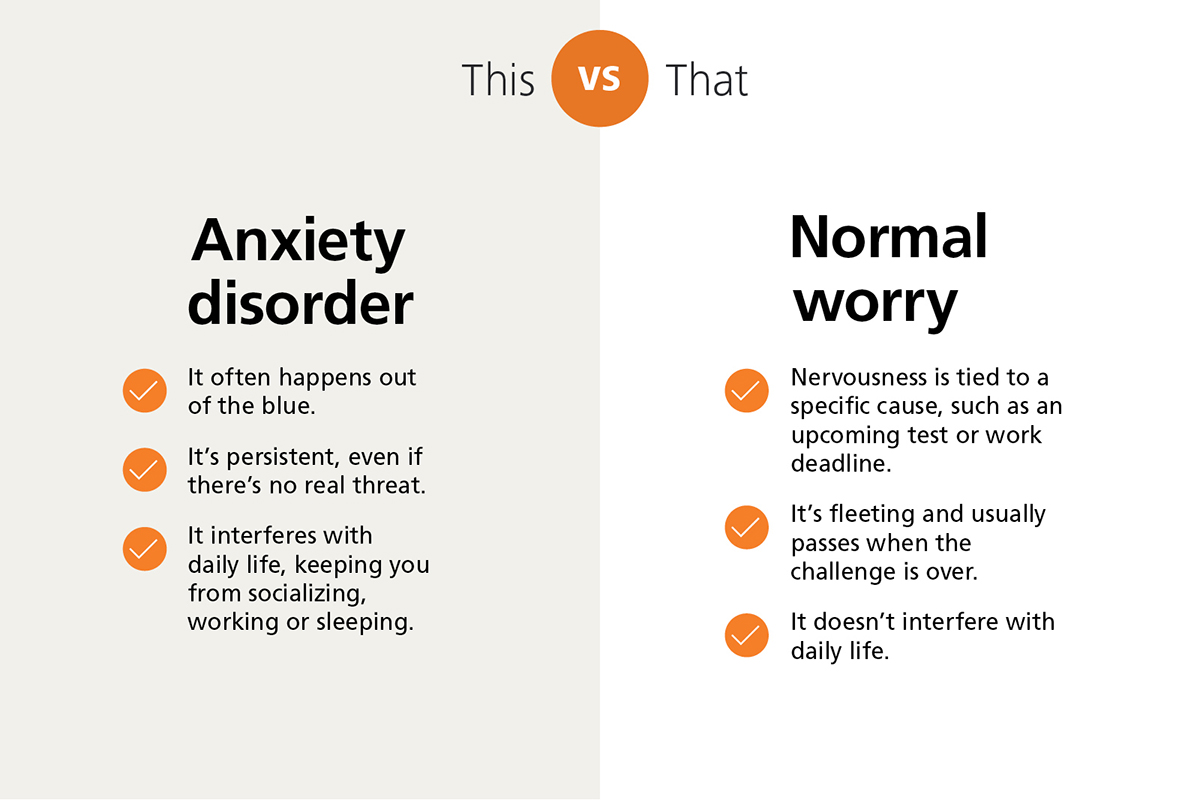
Anxiety: The Optum Store Guide

Worry and fear shouldn’t rule your life. Understanding the causes, symptoms and treatment of anxiety disorders can help you take control.
- What is anxiety, exactly?
- How is an anxiety disorder different than everyday worry?
- What are the symptoms of an anxiety disorder?
- What causes anxiety disorders?
- When should I talk to someone about my anxiety?
- How is anxiety diagnosed?
- Is there a cure for anxiety disorders?
- What are the best treatments for anxiety disorders?
- Which medications can help with managing anxiety disorders?
- How will I know my anxiety treatment Is working?
Everyone feels anxious sometimes. It’s just part of the human experience. Speaking in front of a crowd; driving during a thunderstorm; or facing a looming work deadline--all can make you feel anxiety-induced worry, fear and dread.
But fleeting anxiety that’s tied to a specific cause is different from a persistent feeling you just can’t shake. When anxiety sticks around or causes problems in your everyday life, you might have an anxiety disorder.
In fact, more than 30% of adults experience an anxiety disorder at some point in their lives, according to the National Institute of Mental Health. Meanwhile, about 7% of kids deal with anxiety issues each year, reports the National Alliance on Mental Illness. Anxiety is extremely common. But that doesn’t mean you need to just grin and bear it.
By learning more about what the condition, its symptoms and available treatments, you can take control of anxiety and stop it from controlling your life.

What is anxiety, exactly?
Simply put, anxiety is a feeling of worry or apprehension about what’s to come. Maybe it’s a big meeting with your boss to talk about a potential promotion. Or perhaps it’s a first date or a doctor’s appointment you’ve been putting off.
Any of these scenarios, among many others, can keep you up at night with racing thoughts. They can also trigger physical symptoms:
- Your heart may beat faster.
- Your palms may sweat.
- Your shoulders may tense up so much that they almost meet your ears.
This is a totally normal reaction to things that happen in life sometimes, good and bad. It may seem useless and annoying, but anxiety has a purpose. It’s meant to protect us from danger and allow us to react quickly in threatening situations. You may know it as the fight-or-flight response.
Here’s how it works: You encounter a potential threat. Then your sympathetic nervous system (the fight-or-flight response) automatically kicks in. A flood of stress hormones (mainly adrenaline and cortisol) is released. Those hormones boost alertness and heart rate, pumping extra blood to our muscles.
Breathing quickens, delivering more fresh oxygen to the brain. And our pupils expand so we can see better. All of this (and more) is to prepare our body to move quickly and protect ourselves from danger.
This reaction is incredibly useful when facing down a ferocious animal or an oncoming car at 70 mph. It can also be helpful in less ominous scenarios such as when you need to stay alert and meet a rapidly approaching deadline.
The essential thing to know is that the normal type of anxiety that everyone feels sometimes is fleeting. The feelings of fear and worry (and any symptoms that come along with it) go away once the stressful event is over. You might feel a sense of relief, or even a little silly for being so anxious about it in the first place.
But for people dealing with anxiety disorders, it’s a different story.
How is an anxiety disorder different than everyday worry?
For people suffering from anxiety disorders, the nervousness, worry or fear is persistent and sometimes overwhelming. It’s not always tied to any specific stressor. That means it doesn’t go away when you meet the deadline or avoid the close call on the road.
This type of anxiety can impact your ability to do your job or otherwise function in day-to-day life. While persistence is the key difference, there are other signs you might be dealing with an anxiety disorder, including:
1. You may worry about the same things that other people do, but you take those worries to a whole different level. If a text to a friend isn’t immediately returned, you’re convinced that you did something wrong and the relationship is doomed.
2. Anxiety disorders are often indicated by concern about something that might happen in the future (job loss or a house fire). Typical anxiety usually focuses on something you know is happening (a scheduled surgery or cross-country flight).
This is why the term “imagined threat” is sometimes used to describe what people with anxiety experience. The fear is about something you believe, or imagine, might happen — even if there’s little to no proof that it will.

What are the symptoms of an anxiety disorder?
Anxiety disorders can be divided into 3 primary categories: generalized anxiety disorder (GAD), phobia disorders and panic disorder.
That’s important to know. Symptoms of each anxiety disorder can be different. The symptoms can also vary from person to person. And they can even vary in the same person depending on the day.
One common thread that runs through all anxiety disorders is that the symptoms are both mental and physical. You can thank the mixed messages anxiety sends to the body for that. Here’s a breakdown of how each type of anxiety disorder may affect you:
Generalized anxiety disorder (GAD) symptoms
Types of phobia disorders and their symptoms
Panic disorder symptoms
What causes anxiety disorders?
That is the million-dollar question. Researchers don’t know the exact cause of anxiety disorders. If we did, we’d be much better at preventing and even curing them. What we do know is that anxiety disorders are likely to have a mix of genetic and environmental causes, in combination with certain other factors that can make them more likely (though they don’t guarantee it).
Here’s a closer look:
Like other medical conditions, such as heart disease or diabetes, anxiety disorders are known to run in families. If a biological family member has a history of anxiety or another mental illness, you have a higher risk of developing anxiety at some point in your life, too.
Life is stressful. Certain situations — especially those involving family, work or your social life — can increase the odds of developing an anxiety disorder in those who are vulnerable. For example, during the COVID-19 pandemic, life as we knew it changed almost overnight. The fear and uncertainty around the dangerous new coronavirus made many people feel like they no longer had much control over their lives.
That sort of stressful situation is enough to give anyone anxiety. And it could be especially problematic for someone predisposed to an anxiety disorder.
Going through a traumatic experience in early childhood or adulthood increases your risk of developing an anxiety disorder. This might mean growing up in an abusive or violent home, experiencing the death of a loved one or dealing with a prolonged illness.
When should I talk to someone about my anxiety?
The right time to ask for help with anxiety is as soon as it starts to impact your ability to function in daily life. If anxiety is making it hard to focus and get your work done, interfering with your relationships, or impacting your ability to experience joy or pleasure, it’s time to see a doctor.

How is anxiety diagnosed?
Primary care providers (PCPs) see anxiety disorders in their practices every single day. That makes sense, given that more than 40 million Americans experience them, according to the National Alliance on Mental Illness. They are often first diagnosed by your primary care doctor, whether you see someone in person or virtually. When you make an appointment, here’s what you can expect:
Thorough medical history. If you see your doctor in the office, he or she will likely start by doing a physical examination. The doctor will ask for a rundown of your symptoms and any medications or supplements you take on a regular basis.
The goal is to rule out other health conditions and to find out whether you’re taking anything that has side effects that mimic the symptoms of anxiety. The doctor may also order blood tests as part of the process.
Psychological screening. If your PCP doesn’t find a clear physical cause of your symptoms, he or she will ask you some questions to better understand your specific anxiety symptoms and how they affect your life. The doctor will also want to know about any history of mental health conditions in close relatives such as parents, grandparents or siblings.
If all signs point to anxiety, your doctor may discuss treatment options. Those will likely include psychotherapy (talk therapy) and medication, or they may refer you to a mental health specialist. Some health care practices even have a clinical social worker or counselor on site who can work with you more closely right away.
Referral to a mental health specialist (if needed). Mental health experts use standardized screening tools to figure out whether your symptoms match up with the criteria for an anxiety disorder.
Your general practitioner (GP) might be equipped to do this, too. But not all GPs are trained in fully diagnosing mental health conditions, which is why they sometimes refer you to a specialist after they’ve ruled out other potential conditions.
Since anxiety disorders exist on a spectrum, you might have several symptoms but still not technically meet the criteria for a specific diagnosis. That doesn’t mean your symptoms aren’t valid and worth addressing. In this situation, your doctor or therapist will work with you to come up with a personal plan to control your anxiety.
Remember, you don’t have to just push through these feelings.
Is there a cure for anxiety disorders?
Anxiety disorders are very treatable, according to the American Psychological Association. You probably won’t eliminate anxiety from your life entirely, but you can drastically reduce the symptoms and loosen anxiety’s grip on you. With the right combination of treatments, you will feel better. Anxiety will no longer get in the way of you living your life.
What are the best treatments for anxiety disorders?
The right treatment for you will depend on your specific diagnosis. Generally, anxiety disorders are treated with psychotherapy, medication or a combination of both. Other tools such as exercise and mindfulness meditation can complement traditional treatments.
Psychotherapy. Psychotherapy is an umbrella term for different types of talk therapy, including cognitive-behavioral therapy (CBT), exposure therapy and more. They all aim to give you the tools you need to cope with anxiety — and to make sure you know how to use them.
Cognitive-behavioral therapy (CBT). CBT is a very popular way to treat anxiety. It helps you recognize the negative things you say to yourself (“No one will even notice if I don’t go to the party”). You’ll also learn to recognize any unhealthy behavioral patterns (never leaving the house because of fear that something bad might happen).
Then you’re taught how to challenge them. This helps you realize that you’re in control. You have the power to shift your thoughts and behaviors, which is key to stopping anxiety from interfering with your life.
A large body of research shows that CBT can help ease multiple mental health conditions, including anxiety disorders, depression and eating disorders. And you don’t have to meet with a therapist in person to benefit.
A 2018 study published in the Journal of Anxiety Disorders found that online cognitive behavioral therapy was as effective as face-to-face treatment for major depression, panic disorder, social anxiety disorder and generalized anxiety disorder. (Explore virtual therapy options from Optum Store now.)
Exposure therapy. Exposure therapy is a type of CBT designed to help you overcome fears and anxieties by breaking the pattern of avoiding the thing or situation that scares you. Therapists often use it to treat phobias such as social anxiety disorder or specific phobias. It works by gradually exposing you to whatever scares you, in a safe environment.
For example, if you’re terrified of spiders, the therapist might start by having you look at pictures of spiders. In the next session, they might introduce a live spider in a closed container. Eventually, they might have you hold a spider.
Learn more about how therapy works (and how to afford it).
Other therapies and lifestyle habits. Your doctor may teach you other therapy tactics, such as visualization or deep breathing exercises, that you can use in conjunction with psychotherapy. These techniques can be helpful when you need a little something extra to get through a particularly stressful time.
While it’s not exactly a treatment, exercise can make a big difference in managing anxiety. And you don’t have to commit to hour-long daily sweat sessions. Research published in the Expert Review of Neurotherapeutics suggests that just 30 minutes of exercise 3 or 4 times per week can be enough to reduce anxiety.
Which medications can help with managing anxiety disorders?
While psychotherapy is extremely helpful for many people, others also benefit from medications. Often the most effective treatment involves a combination of both.
Anxiety medications don’t cure anxiety, but they can relieve symptoms and help you feel well enough to tackle your anxiety head-on. The most common types of medications prescribed for anxiety disorders are antidepressants and antianxiety medications.
If your treatment plan includes medication, the Optum Store can take the hassle out of managing it. Sign up for free home delivery and access our best prices. No insurance required.
Antidepressants. The same medications used to treat depression are often very helpful in treating anxiety disorders. One such class of medications are selective serotonin reuptake inhibitors (SSRIs). They work by increasing levels of serotonin, a chemical in the brain that helps regulate mood and sleep.
You may notice minor improvements in mood, sleep or your capacity to deal with stress within a couple of weeks. But SSRIs typically take up to 2 months to fully kick in. Like all medications, SSRIs come with potential side effects, but they’re generally mild. Some of the more common ones include:
- Nausea and upset stomach
- Headaches
- Dry mouth
- Sexual problems
You may also experience withdrawal symptoms if you stop taking SSRIs abruptly. It’s best to taper off them slowly and only under your doctor’s supervision. As always, you should talk with your doctor about potential side effects of your specific prescription.
Common SSRIs used to treat anxiety include:
Another class of antidepressant medications known as selective norepinephrine reuptake inhibitors (SNRIs) are also sometimes used to treat anxiety. They work by increasing the amount of both serotonin and norepinephrine, a brain chemical involved in attention and mood. SNRIs have similar side effects as SSRIs.
Common SNRIs used to treat anxiety include:
Anti-anxiety medications. These medications work to reduce the symptoms of anxiety quickly — sometimes within an hour. That makes them especially helpful for people experiencing overwhelming anxiety or panic attacks.
Benzodiazepines are the most common class of anti-anxiety medications. They work by sedating you, or slowing the brain and nervous system. This helps relax your muscles and calm down racing thoughts. It also makes it easier to fall asleep if you’re struggling with insomnia.
Benzodiazepines have some drawbacks. Specifically, their ability to bring immediate relief makes them more likely to be addictive. Plus, you can build up a tolerance to them and may need increasingly higher doses to get the same effect.
That, in addition to their sedative effects, means benzodiazepines are usually considered a second-line treatment for long-term anxiety control. Instead, they are typically used as needed to quickly calm down spiraling anxiety in the moment. Talk to your doctor to see if they are right for you.
Common benzodiazepines used for anxiety include:
There are also nonbenzodiazepine medication options. Buspirone is a nonbenzodiazepine anti-anxiety medication used to treat both anxiety in the moment and over the long term in some people. It works by impacting chemicals in the brain that are responsible for mood regulation, specifically serotonin.
Some health care providers may also consider a beta-blocker as an alternative to benzodiazepines as a second-line treatment of anxiety. These blood-pressure-lowering medications, such as propranolol, can ease symptoms of anxiety on an as-needed basis. They help block adrenaline and manage symptoms such as increased heart rate, sweating and dizziness.
How will I know my anxiety treatment Is working?
The simple answer: You’ll just feel better. It may take time, depending on your exact treatment, but you’ll start to notice your symptoms are less intense and less frequent. You may be sleeping better or realize that things that used to work you up don’t cause as much worry as they used to. And ideally, you’ll start to enjoy your favorite activities and hobbies again, too.
There are also rating scales your doctor can use to measure your anxiety. Two examples include:
- The GAD-7, which is used to measure generalized anxiety disorder
- The Social Phobia Inventory (SPIN), which is used to assess social phobias in adults
Rating your symptoms before and during treatment makes it easy for you and your doctor to see how well your treatment is working or whether anything needs adjusting.
It’s also helpful to track symptoms on your own. If you’re not seeing significant improvements after 8 to 10 weeks, it’s time to check in with your doctor or other provider (e.g., a psychotherapist). They may want to prescribe a higher dose or a different medication, or add another type of treatment (e.g., combined psychotherapy and medication), to make sure you’re seeing progress and feeling your best.

Our expert panel
Martin H. Rosenzweig, MD
Senior Behavioral Medical Director at Optum
Brenna Renn, PhD
Clinical psychologist and assistant professor at the University of Nevada, Las Vegas
Renee Exelbert, PhD
Psychologist and adjunct professor of psychology at the New York University Steinhardt School of Culture, Education and Human Development
Additional sources
Types of anxiety disorders: National Institute of Mental Health, Anxiety Disorders
Fight-or-flight response: Merck Manual: Consumer Version (2020). “Overview of the Autonomic Nervous System”
How the brain responds to stress: Harvard Health Publishing: Harvard Medical School (2020). “Understanding the stress response”
Generalized anxiety disorder: National Institute of Mental Health, Generalized Anxiety Disorder: When Worry Gets Out of Control
Statistics on anxiety: National Alliance on Mental Illness, Anxiety Disorders
Panic attacks and panic disorder: National Institute of Mental Health, Panic Disorder: When Fear Overwhelms
About CBT: American Psychological Association (2017). “What Is Cognitive Behavioral Therapy?”
About exposure therapy: American Psychological Association (2017). “What Is Exposure Therapy?”
Medications for treating anxiety: Anxiety & Depression Association of America (2020). “SSRIs and Benzodiazepines for GAD”
Assessment tools for anxiety symptoms: American Psychological Association: Society of Clinical Psychology
